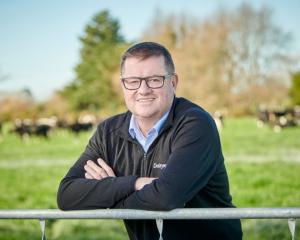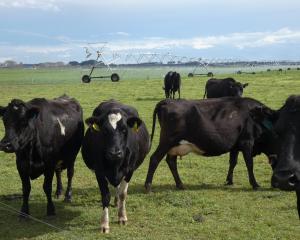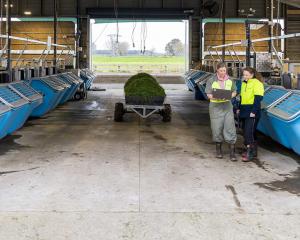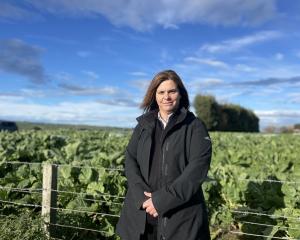
Will a moo still do?
Food technologist Anna Benny believes it is possible — and probable — that commercial scale, functional replicas of dairy ingredients made without animals will become commonplace within the next 10 years.
Rather than being produced by a dairy cow — a familiar scene in New Zealand’s rural countryside — they would be grown via cellular agriculture, produced with precision fermentation or isolated from plants.
This is high-tech stuff; forget curdled soy milk in the morning cup of tea, or hard, dry burgers created from mashed chickpeas.
Mrs Benny says the world has moved on and she believes "alternative protein" will be a term consigned to the past.
A deep understanding of foods at a molecular level and how that influenced function and flavour was bringing appealing products to the market, whether it was a vege burger that "bleeds" or icecream made with animal-free dairy protein, she said.
And it was no longer just protein in the spotlight; new technologies could replicate fats and other components of animal products.
Animal ingredients were being reverse engineered to be made from non-animal sources.
Alternative protein had not affected New Zealand’s primary industries in any major way so far, Mrs Benny said.
Risk was often considered in relation to the meat industry but it was dairy that was the "low-hanging fruit" for alternatives.
Meat was complex as it had many structural, textural and inconsistent aspects, making it very complicated to replicate successfully.
In contrast, milk was a homogenous product; it was always a liquid consisting of 87% water and 13% solids.
There were three ways milk alternatives were produced:
- Plant-based— utilising ingredients such as soy, nuts or oats combined with water to produce a milk-like substance.
- Precision fermentation — programming micro-organisms such as yeast to produce molecules such as proteins, fats and vitamins, then combining these to produce a milk product or replicate dairy ingredients.
- Cell culturing — taking existing milk-producing (mammary) cells, culturing them to increase their number, then using these to produce milk outside the body of a mammal.
Alternative dairy, especially precision fermentation, represented a "significant risk" to the industry due to the reliance on commodity ingredient products which would be easiest to replicate, Mrs Benny said.
Advanced economies that New Zealand tended to compare itself with were moving rapidly, investing in research via partnerships between government, research institutions and industry, and New Zealand risked being left behind, she said.
She believed the New Zealand dairy industry needed to "act now" — acknowledge the risk and react.
New Zealand was the largest dairy exporter in the world and those exports were mostly used as ingredients in other foods.
In 2021, Fonterra made 74% of the milk it processed into ingredients.
New Zealand provided 60% of the world’s whole milk powder exports — a large proportion of that went to China to supplement its domestic milk production.
But the retail market for milk powder paled in comparison to the demand for drinking yoghurt, shelf-stable milk and flavoured milk drinks, which were most likely what Chinese food manufacturers produced with New Zealand milk powder, she said.
When dairy products became ingredients in processed food items, they were treated as commodities, comparable with the same product specification made all over the world and competing only on price.
"They lose their origin story, which is what New Zealand prides itself on.
"Consumers don’t value the fact that the milk powder in their processed food, such as a chocolate bar, is made with New Zealand milk powder, so any competitive story associated with New Zealand production methods is lost," she wrote in her report.
Plant-based liquid dairy alternatives such as oat and soy milk were not a threat as New Zealand only exported a small amount of liquid milk, Mrs Benny said.
Alternatives were aiming to disrupt the business-to-business ingredients industry, the very same market that New Zealand dairy thrived in.
Individual proteins (whey and casein) were the initial targets for precision fermentation technology.
It was long, intensive process to produce a tonne of milk powder.
"You need to grow a cow, complete with head, bones, hooves, tail etc.
"You can’t milk her for the first two years until she’s had a calf.
"Once she’s in the milking herd, she needs enough food and water to stay alive, walk to the milking shed twice a day and produce milk.
"If there’s enough grass in the paddock this will form the majority of her diet, [but] it’ll normally be topped up with supplementary feed such as hay or palm kernel expeller [PKE]."
Milk had to be collected and driven to another location, where the water (87% of milk) was removed via spray drying, leaving just the 13% solids available to sell.
In contrast, precision fermentation technology bypassed such a wasteful process, using a tank of microbes consuming sugar to produce exactly the same molecules as milk — if they were assessed under a microscope, it would be impossible to tell whether they were from a cow or a fermentation tank, she said.
A small range of "animal-free dairy" products made via precision fermentation were commercially available in the United States.
A few companies were leading the way with precision fermentation dairy alternatives, all at different stages of scaling up.
The number of companies in the sector was rising rapidly.
Investment was a key factor in enabling the alternatives to dairy to grow to a point where they could be viable alternatives to dairy products made in New Zealand.
Funding for alternative protein was growing. The industry had many enablers: high net-worth backers such as Bill Gates were investing via their venture capital firms.
Consumers were increasingly demanding foods that were more ethical, sustainable and nutritious to improve both their own health and that of the planet.
But there was a limit to the level of sacrifice consumers were willing to make, and often taste and price won over sustainability and health credentials when it came to food choice.
"The argument that consumers won’t accept new alternatives because of their production methods do not stack up — precision fermentation is already used to produce common food ingredients such as rennet in cheese."
The risk of disruption was not coming from within New Zealand — "it’s not individuals who don’t agree with dairy farming, and it’s certainly not from oat milk lattes".
"It can’t be solved by resorting to the ‘grass-fed, free-range, high-quality’ standpoint that is so often quoted within New Zealand, which in reality doesn’t travel with the majority of our dairy produce to the end consumer.
"This is a global movement, driven by purpose-orientated start-ups and accelerated by large food corporates looking to meet sustainability goals and maintain their social licence to operate."
There needed to be open-minded coverage of the challenges and opportunities New Zealand could face from emerging technologies — not the "them and us" rhetoric.
A high burden of responsibility would sit with dairy processors, which took the responsibility for converting milk into saleable products.
They would need the support of farmers to make the transition.
"While the current market for NZ dairy is strong, it is incredibly important this drives investment into future adaptation rather than endorsing the current business model.
"There is a real risk here, and by burying our heads in the sand, we could well miss the opportunity to react."
New Zealand dairy had a unique opportunity to become involved in emerging technologies.
"Downstream processing" of ingredients had been identified as a key bottleneck for the alternatives industry.
Those were processes (filtration, separation, spray drying), in which New Zealand had significant expertise, and equipment capacity which was often underused in dairy processing.
Mrs Benny said the term "value-add" elicited eye-rolls from many in the industry — it was regularly referred to as the way to "fix" the primary industry but few did it well and it was extremely difficult to achieve at scale.
The issue for New Zealand dairy was that reliance on commodity ingredient products left it very exposed to alternatives.
The key would be to make products where consumers valued the inclusion of dairy ingredients.
Luxury, niche dairy products, at scale needed to be the aim, she said.
"I truly believe that the industry has the strength to weather this disruption, but to do so successfully requires a shift in mindset and strategy from multiple angles, the scale of which will be hugely challenging to most.
"It’s a shift that is mostly being overlooked."
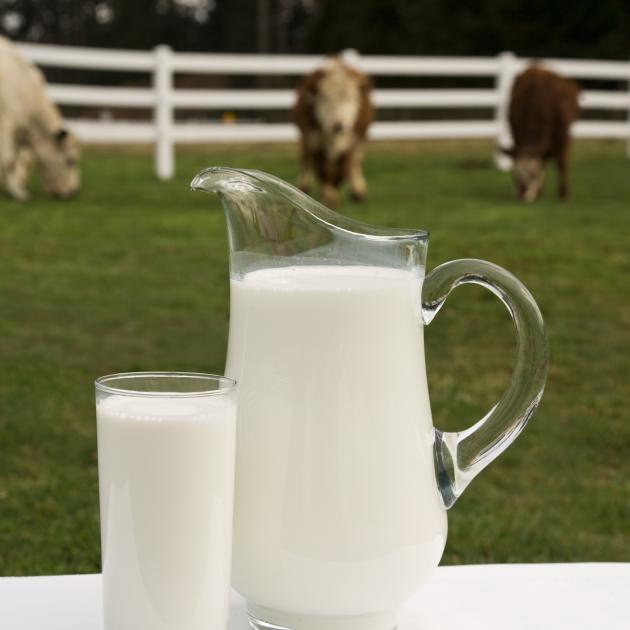
Blame it all on Willy Wonka.
Anna Benny attributes the Roald Dahl classic Charlie and the Chocolate Factory for whetting her interest in food production from an early age.
For her, going into a factory and seeing how food was made was genuinely like seeing the chocolate river in the children’s book.
A television programme in the United Kingdom, where she grew up, called Ready Steady Cook, provided contestants with a bag of ingredients from which they had to create a meal.
She enjoyed watching that and seeing how they worked out what to do. Airline food was another fascination as she pondered how it was prepared ready for passengers’ consumption, and she was also keen to design food for astronauts.
So it was no surprise that, after leaving school, Mrs Benny studied food science at the University of Nottingham.
During her studies she spent a year working in industry, which included a stint at a pie factory where she worked as a process technologist, transferring kitchen concepts into the factory.
Asked whether she tired of pies, she admitted that taste-testing was usually held about 8am and pork pies for breakfast was not something she was accustomed to.
After graduating, she got a job working for Sainsbury’s, undertaking a variety of placements at Sainsbury’s suppliers around the world, learning how they operated and the challenges they faced.
Her experiences included bananas and pineapples in Costa Rica and Panama, sweet potatoes in Senegal and lamb at Alliance Group in New Zealand. From there, she spent four years as a product technologist for Sainsbury’s.
In New Zealand, she had previously met a "lovely" Clydevale dairy farmer called Pete Benny on the stairs of the Base backpackers hostel in Queenstown. Despite returning to London, she could not get him out of her head.
She called her old boss at Alliance Group and asked if there were any jobs available. She joined the Omega lamb project for a year and a-half.
The role was primarily focused on supporting the development of Te Mana Lamb. She worked across the whole lamb supply chain, from farmer engagement, tracking of animals and testing of genetic traits, through to quality control and inventory management in the processing plant.
After moving to the farm at Clydevale — a far cry from central London — it became a long commute to Alliance.
She was looking for something she could do from her new home, while using her food technology background.
For the past four years, she has worked for a chemical manufacturer, going into food and dairy processing factories and looking at their cleaning programmes. It also provided insight into what happened to milk once it left the farm.
Her own experience living on a dairy farm meant she was acutely aware of how much work went into producing high-quality milk while maximising animal health and minimising effects on the environment, she said.
"Large investments are often calculated with a long payback period and it concerns me that the industry could look very different in 10 years.
"My husband and I welcomed our first child this year — if he wanted to continue the family farm, how can we make sure the business is future-proofed for him?"
She never thought she would go back to academia but had thoroughly enjoyed the Kellogg Rural Leadership Programme.
She was fortunate to have a "lucky set of circumstances" when it came to her research topic. She lived on a dairy farm, which motivated her to look more into what the risks to the industry were, and her food science background meant she understood how those behind milk alternatives would scale up.
Kellogg gave her a reason to investigate the topic further. While it was supposed to be a six-month programme, it took her a little over a year as Henry was born during the last phase.
She realised her report could mean she was perceived as being "against" the dairy industry, which could not be further from the truth, Mrs Benny said.
"I want to make it clear this is not my intention — I love the passion of Kiwi farmers, and the pride they have in the industry. Researching this report from our dairy farm ... watching the cows leave the shed after milking, I felt both a sense of unease and urgency about the changes required to future-proof the industry," she said.
She felt very lucky to have such a supportive husband and to live on the farm and enjoy the rural lifestyle.
It was an "amazing" industry but those involved in it needed to have their "eyes well and truly open" and think about the consumer, she said.
Comments
Fantastic article, well written, interesting and very knowledgeable. Well done Anna and Pete, keep up the great work. We need to be constantly learning and reassessing all aspects of NZ industries and life in Aotearoa.








